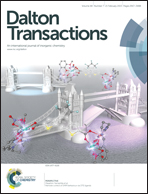Activation of the manganese(i) tricarbonyl core by selective variation of bidentate ligands (L,L′-Bid = N,N′ and N,O donor atom sets) in fac-[Mn(CO)3(L,L′-Bid)(CH3OH)]n complexes†
Abstract
A range of fac-[Mn(CO)3(L,L′-Bid)(H2O)]n (L,L′-Bid = neutral or monoanionic bidentate ligands with varied L,L′ donor atoms, N,N′ and N,O, 1,10-phenanthroline, 2,2′-bipyridine, 2-picolinate, 2,4-quinolinate; n = 0, +1) has been synthesized and the methanol substitution has been investigated for the first time. The complexes were characterized by UV/vis, IR and NMR spectroscopy and X-ray crystallographic studies of the compounds fac-[Mn(CO)3(Bipy)(H2O)][CF3SO3] (1) and fac-[Mn(CO)3(Phen)(H2O)][CF3SO3] (6) are reported. A two order-of-magnitude of activation for the methanol substitution is induced as manifested by the second order rate constants with (N,N′-Bid) < (N,O-Bid). Forward and reverse rate and stability constants from slow and stopped-flow UV/vis measurements (k1, M−1 s−1; k−1, s−1; K1, M−1) for pyridine as entering nucleophile are as follows: fac-[Mn(CO)3(Phen)(CH3OH)]+ (2.39 ± 5) × 10−3, (1.5 ± 0.3) × 10−5, 159 ± 32; fac-[Mn(CO)3(2,4-QuinH)(CH3OH)] (4.5 ± 0.2), (4 ± 1) × 10−2, 113 ± 29. Activation parameters (ΔH≠k1, kJ mol−1; ΔS≠k1, J K−1 mol−1) from Eyring plots for entering nucleophiles as indicated are as follows: fac-[Mn(CO)3(Phen)(CH3OH)]+ (bromide ions) 66.7 ± 0.6, −27 ± 2; (pyridine) 80 ± 3, −25 ± 11; fac-[Mn(CO)3(Pico)(CH3OH)] (bromide ions) 68 ± 2, −24 ± 5. A dissociative interchange mechanism is proposed.
![Graphical abstract: Activation of the manganese(i) tricarbonyl core by selective variation of bidentate ligands (L,L′-Bid = N,N′ and N,O donor atom sets) in fac-[Mn(CO)3(L,L′-Bid)(CH3OH)]n complexes](/en/Image/Get?imageInfo.ImageType=GA&imageInfo.ImageIdentifier.ManuscriptID=C4DT03524K&imageInfo.ImageIdentifier.Year=2015)

 Please wait while we load your content...
Please wait while we load your content...